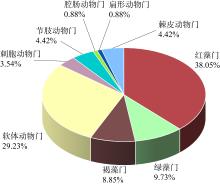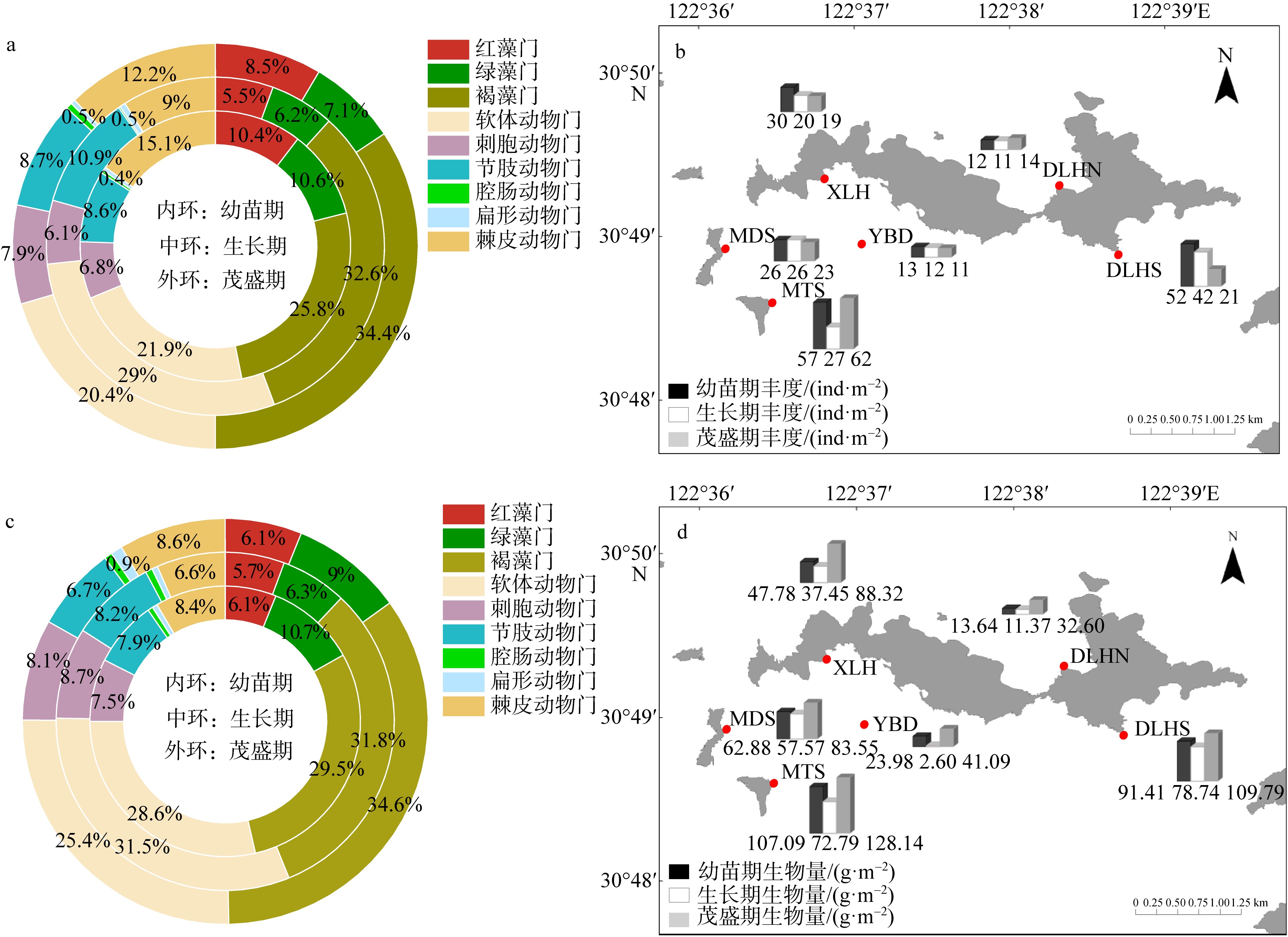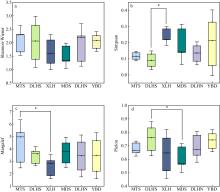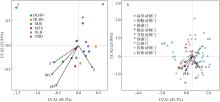Journal of Tropical Oceanography ›› 2025, Vol. 44 ›› Issue (4): 119-135.doi: 10.11978/2024188
• Marine Ecology • Previous Articles Next Articles
Structure of macrobenthic community in the seaweed beds of Lvhua Island waters and its response to environmental factors
SUN Jianing1( ), WANG Yuqing1, ZHANG Shouyu1,2,3, WANG Kai1,2,3(
), WANG Yuqing1, ZHANG Shouyu1,2,3, WANG Kai1,2,3( )
)
- 1. College of Oceanography and Ecological Science, Shanghai Ocean University, Shanghai 201306, China
2. Engineering Technology Research Center of Marine Ranching, Shanghai Ocean University, Shanghai 201306, China
3. Marine Ranching Comprehensive Workstation of the East China Sea, Expert Advisory Committee of Marine Ranching Construction, Ministry of Agriculture and Rural Affairs, Shanghai 201306, China
-
Received:2024-10-08Revised:2024-11-05Online:2025-07-10Published:2025-07-31 -
Contact:WANG Kai -
Supported by:National Key Research and Development Program of China(2018YFD0900904); National Key Research and Development Program of China(2019YFD0901303); National Natural Science Foundation of China(41876191)
CLC Number:
- P735
Cite this article
SUN Jianing, WANG Yuqing, ZHANG Shouyu, WANG Kai. Structure of macrobenthic community in the seaweed beds of Lvhua Island waters and its response to environmental factors[J].Journal of Tropical Oceanography, 2025, 44(4): 119-135.
share this article
Add to citation manager EndNote|Reference Manager|ProCite|BibTeX|RefWorks

Fig. 3
Composition of macrozoobenthos species at different growth stages and sampling stations. In Fig. 3b, the letters M, D, X, J, B, and Y represent the six sampling stations: MTS, DLHS, XLH, MDS, DLHN, and YBD, respectively. The numbers 8, 11, and 6 correspond to the three growth stages: seedling stage, growth stage, and flourishing stage"

Tab. 1
Spatiotemporal distribution of dominant macrobenthic species in seaweed beds"
| 站点 | 时期 | 优势种和重要种 |
|---|---|---|
| MTS | 幼苗期 | **瓦氏马尾藻 Sargassum vachellianum、羊栖菜 Sargassum fusiforme、锈凹螺Chlorostoma rustica、**紫海胆 Anthocidaris crassispina、黄口荔枝螺 Thais luteostoma、甲虫螺 Cantharus cecillei |
| 生长期 | **瓦氏马尾藻 Sargassum vachellianum、珊瑚藻 Corallina officinalis、锈凹螺 Chlorostoma rusticum、**紫海胆 Anthocidaris crassispina、黄口荔枝螺 Thais luteostoma | |
| 茂盛期 | **瓦氏马尾藻 Sargassum vachellianum、羊栖菜 Sargassum fusiforme、锈凹螺 Chlorostoma rusticum、**紫海胆 Anthocidaris crassispina、黄口荔枝螺 Thais luteostoma、甲虫螺 Cantharus cecillei | |
| DLHS | 幼苗期 | **铜藻 Sargassum horneri、鼠尾藻 Sargassum thunbergii、**锈凹螺 Chlorostoma rusticum、**紫海胆 Anthocidaris crassispina、黄口荔枝螺 Thais luteostoma、甲虫螺 Cantharus cecillei |
| 生长期 | 铜藻 Sargassum horneri、**珊瑚藻 Corallina officinalis、**锈凹螺 Chlorostoma rusticum、 黄口荔枝螺 Thais luteostoma、甲虫螺 Cantharus cecillei | |
| 茂盛期 | **铜藻 Sargassum horneri、羊栖菜 Sargassum fusiforme、**锈凹螺 Chlorostoma rusticum、 黄口荔枝螺 Thais luteostoma、甲虫螺 Cantharus cecillei | |
| XLH | 幼苗期 | **瓦氏马尾藻 Sargassum vachellianum、**锈凹螺 Chlorostoma rusticum、黄口荔枝螺 Thais luteostoma、甲虫螺 Cantharus cecillei |
| 生长期 | **瓦氏马尾藻 Sargassum vachellianum、羊栖菜 Sargassum fusiforme、锈凹螺 Chlorostoma rusticum、黄口荔枝螺 Thais luteostoma、甲虫螺 Cantharus cecillei | |
| 茂盛期 | **瓦氏马尾藻 Sargassum vachellianum、囊藻 Colpomenia sinuosa、**锈凹螺 Chlorostoma rusticum、黄口荔枝螺 Thais luteostoma、甲虫螺 Cantharus cecillei | |
| MDS | 幼苗期 | **瓦氏马尾藻 Sargassum vachellianum、羊栖菜 Sargassum fusiforme、**锈凹螺 Chlorostoma rusticum、**紫海胆 Anthocidaris crassispina、黄口荔枝螺 Thais luteostoma、甲虫螺 Cantharus cecillei |
| 生长期 | **瓦氏马尾藻Sargassum vachellianum、 珊瑚藻Corallina officinalis、**锈凹螺 Chlorostoma rusticum、**紫海胆 Anthocidaris crassispina、黄口荔枝螺 Thais luteostoma | |
| 茂盛期 | **瓦氏马尾藻 Sargassum vachellianum、羊栖菜 Sargassum fusiforme、**锈凹螺Chlorostoma rusticum、**紫海胆 Anthocidaris crassispina、 黄口荔枝螺 Thais luteostoma、甲虫螺 Cantharus cecillei | |
| DLHN | 幼苗期 | **羊栖菜 Sargassum fusiforme、鼠尾藻 Sargassum thunbergii、**锈凹螺 Chlorostoma rusticum、甲虫螺 Cantharus cecillei |
| 生长期 | **羊栖菜 Sargassum fusiforme、鼠尾藻 Sargassum thunbergii、**锈凹螺 Chlorostoma rusticum、甲虫螺 Cantharus cecillei、疣荔枝螺 Reishia clavigera | |
| 茂盛期 | **羊栖菜 Sargassum fusiforme、鼠尾藻 Sargassum thunbergii、**锈凹螺 Chlorostoma rusticum、甲虫螺 Cantharus cecillei、疣荔枝螺 Reishia clavigera | |
| YBD | 幼苗期 | 石莼 Ulva lactuca L.、铜藻 Sargassum horneri、舌状蜈蚣藻 Grateloupia livida、瘤荔枝螺 Thais bronni、麦秆虫Caprella septentrionalis |
| 生长期 | **密毛沙菜 Hypnea boergesenii、裂片石莼 Ulva fasciata | |
| 茂盛期 | **铜藻 Sargassum horneri、密毛沙菜 Hypnea boergesenii、石莼 Ulva lactuca L. |
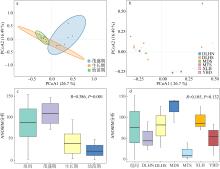
Fig. 6
PCoA and ANOSIM analyses of macrobenthic community structure. (a, c) Analysis and difference testing of the macrobenthic community structure differences across three periods; (b, d) analysis and difference testing of the macrobenthic community structure differences among six sites, respectively"

Tab. 2
ANOVA significance tests of four environmental factors among different stations and growth stages"
| 站点 | 生长时期 | T/℃ | S/‰ | pH | DO/(mg·L-1) |
|---|---|---|---|---|---|
| MTS | 幼苗期 | 26.50±0.34 | 28.25±0.26 | 9.54±0.05 | 9.10±0.28 |
| 生长期 | 22.10±0.49 | 27.82±0.31 | 9.35±0.06 | 8.37±0.46 | |
| 茂盛期 | 23.51±0.15 | 28.42±0.37 | 9.27±0.06 | 7.30±0.14 | |
| DLHS | 幼苗期 | 26.91±0.18 | 28.10±0.15 | 9.57±0.04 | 7.02±0.31 |
| 生长期 | 21.97±0.13 | 27.76±0.36 | 9.33±0.06 | 8.27±0.37 | |
| 茂盛期 | 26.27±0.16 | 28.55±0.36 | 9.43±0.03 | 9.00±0.36 | |
| XLH | 幼苗期 | 26.70±0.24 | 27.21±0.19 | 9.43±0.03 | 9.00±0.11 |
| 生长期 | 21.30±0.40 | 27.65±0.36 | 9.20±0.01 | 8.37±0.32 | |
| 茂盛期 | 23.42±0.42 | 28.15±0.37 | 8.97±0.09 | 7.14±0.30 | |
| MDS | 幼苗期 | 27.40±0.18 | 28.21±0.36 | 9.46±0.04 | 9.10±0.18 |
| 生长期 | 21.50±0.35 | 27.54±0.11 | 9.31±0.06 | 8.32±0.46 | |
| 茂盛期 | 23.47±0.41 | 28.39±0.20 | 9.16±0.02 | 7.22±0.12 | |
| DLHN | 幼苗期 | 25.54±0.19 | 28.42±0.43 | 9.29±0.07 | 9.00±0.25 |
| 生长期 | 20.54±0.39 | 26.74±0.34 | 9.18±0.04 | 8.32±0.45 | |
| 茂盛期 | 25.64±0.11 | 28.38±0.15 | 9.09±0.01 | 9.22±0.15 | |
| YBD | 幼苗期 | 26.50±0.27 | 27.17±0.38 | 9.14±0.09 | 9.23±0.49 |
| 生长期 | 21.50±0.26 | 27.16±0.39 | 9.08±0.03 | 8.23±0.41 | |
| 茂盛期 | 21.96±0.16 | 27.45±0.14 | 9.06±0.04 | 7.21±0.45 | |
| ANOVA | P<0.05 | P<0.05 | P<0.05 | P=0.42 |
| [1] |
包炎琳, 段元亮, 杨娜, 等, 2020. 嵊泗列岛贻贝养殖区与无人岛潮间带大型海藻群落结构比较[J]. 海洋渔业, 42(5): 595-607.
|
|
|
|
| [2] |
毕远新, 章守宇, 王伟定, 等, 2014. 枸杞岛铜藻垂直分布格局及成因分析[J]. 生态学报, 34(17): 4931-4937.
|
|
|
|
| [3] |
柴召阳, 霍元子, 于克锋, 等, 2013. 枸杞岛瓦氏马尾藻藻场生态系统健康评价[J]. 海洋环境科学, 32(3): 386-389.
|
|
|
|
| [4] |
陈亮然, 章守宇, 陈彦, 等, 2015. 枸杞岛马尾藻场铜藻的生命史与形态特征[J]. 水产学报, 39(8): 1218-1229.
|
|
|
|
| [5] |
丁朋朋, 高春霞, 田思泉, 等, 2019. 浙江南部近海蟹类群落结构及其与环境因子的关系[J]. 海洋渔业, 41(6): 652-662.
|
|
|
|
| [6] |
董世淇, 张合烨, 孙国庆, 等, 2023. 北黄海褡裢岛海藻场邻近海域大型底栖动物群落营养结构的季节变化[J]. 应用生态学报, 34(7): 1763-1770.
doi: 10.13287/j.1001-9332.202307.029 |
|
doi: 10.13287/j.1001-9332.202307.029 |
|
| [7] |
傅海霞, 张玉洲, 黄书雅, 等, 2024. 徽水河底栖动物群落结构季节动态及构建机制[J]. 长江流域资源与环境, 33(6): 1239-1249.
|
|
|
|
| [8] |
胡益峰, 蒋红, 柳涛, 等, 2015. 马鞍列岛保护区海域水环境质量分区评价[J]. 海洋环境科学, 34(2): 240-244.
|
|
|
|
| [9] |
黄宗国, 林茂, 2012. 中国海洋生物图集. 第二册[M]. 北京: 海洋出版社: 255-305 (in Chinese).
|
| [10] |
金文育, 彭欣, 王宁, 等, 2017. 渔山列岛夏季潮间带大型底栖生物群落结构研究[J]. 海洋科学, 41(3): 17-25.
|
|
|
|
| [11] |
李宝泉, 李新正, 陈琳琳, 等, 2019. 中国海岸带大型底栖动物资源[M]. 北京: 科学出版社: 99-268.
|
|
|
|
| [12] |
李训猛, 章守宇, 王凯, 等, 2020. 周年温度变化对枸杞岛铜藻生长特性的影响[J]. 海洋与湖沼, 51(5): 1136-1143.
|
|
|
|
| [13] |
李志鹏, 杜震洪, 张丰, 等, 2016. 基于GIS的浙北近海海域生态系统健康评价[J]. 生态学报, 36(24): 8183-8193.
|
|
|
|
| [14] |
梁金玲, 汪振华, 章守宇, 等, 2016. 马鞍列岛海洋特别保护区虾类组成及其多样性[J]. 上海海洋大学学报, 25(1): 124-134.
|
|
|
|
| [15] |
梁静香, 周永东, 王忠明, 等, 2020. 三门湾大型底栖动物群落结构及其与环境因子的关系[J]. 应用生态学报, 31(9): 3187-3193.
doi: 10.13287/j.1001-9332.202009.037 |
|
|
|
| [16] |
廖一波, 曾江宁, 陈全震, 等, 2007. 嵊泗海岛不同底质潮间带春秋季大型底栖动物的群落格局[J]. 动物学报, 53(6): 1000-1010.
|
|
|
|
| [17] |
刘书荣, 周曦杰, 崔潇, 等, 2020. 贻贝筏式养殖区海藻群落对两类代表性藻栖端足目种群特征的影响[J]. 水产学报, 44(3): 461-468.
|
|
|
|
| [18] |
刘涛, 2017. 南海常见大型海藻图鉴[M]. 北京: 海洋出版社: 37-142 (in Chinese).
|
| [19] |
刘涛, 2018. 黄、渤海及东海常见大型海藻图鉴[M]. 北京: 海洋出版社: 43-161 (in Chinese).
|
| [20] |
刘媛媛, 张建伟, 韩军军, 等, 2015. 枸杞岛瓦氏马尾藻养殖及其对水环境因子的影响[J]. 生态学杂志, 34(11): 3214-3220.
|
|
|
|
| [21] |
卢占晖, 朱文斌, 徐开达, 等, 2023. 浙江沿岸海域螺贝类群落结构及其季节变化[J]. 海洋与湖沼, 54(1): 276-285.
|
|
|
|
| [22] |
陆艳用, 马玉心, 崔大练, 等, 2011. 中街山列岛保护区底栖海藻分布与资源特征[J]. 水产科学, 30(5): 269-275.
|
|
|
|
| [23] |
马文刚, 夏景全, 魏一凡, 等, 2022. 三亚蜈支洲岛海洋牧场近岛区底表大型底栖动物群落结构及评价[J]. 热带海洋学报, 41(3): 135-146.
doi: 10.11978/2021125 |
|
doi: 10.11978/2021125 |
|
| [24] |
毛翰宣, 秦诗立, 徐博文, 等, 2021. 浙江舟山群岛新区主要海岛功能布局研究[J]. 海洋开发与管理, 38(12): 46-51.
|
|
|
|
| [25] |
毛欣欣, 蒋霞敏, 林清菁, 2011. 浙江大型海藻彩色图集[M]. 北京: 科学出版社: 87-149.
|
|
|
|
| [26] |
裴文豪, 胡成业, 张秀梅, 等, 2023. 枸杞岛贻贝养殖区大型底栖动物群落结构及与环境因子的关系[J]. 海洋与湖沼, 54(2): 526-536.
|
|
|
|
| [27] |
彭欣, 谢起浪, 李尚鲁, 等, 2010. 浙南潮间带大型底栖藻类时空分布及多样性研究[J]. 热带海洋学报, 29(3): 135-140.
|
|
doi: 10.11978/j.issn.1009-5470.2010.03.135 |
|
| [28] |
宋晨, 许丽婷, 王晓波, 等, 2022. 浙江舟山海域大型底栖动物群落组成及主要影响因子分析[J]. 海洋与湖沼, 53(6): 1585-1597.
|
|
|
|
| [29] |
田阔, 胡扬, 王一航, 等, 2024. 枸杞岛不同生境大型藻类与藻床无脊椎动物功能群的关联性分析[J]. 海洋与湖沼, 55(5): 1172-1182.
|
|
|
|
| [30] |
王航俊, 姚炜民, 林义, 等, 2020. 乐清湾大型底栖动物群落及其与环境因子之间的关系[J]. 海洋学报, 42(2): 75-86.
|
|
|
|
| [31] |
王蕾, 2011. 枸杞岛海藻场生态系统与鱼类群落季节变化的关系[D]. 上海: 上海海洋大学.
|
|
|
|
| [32] |
王蕾, 章守宇, 汪振华, 等, 2011. 枸杞岛近岸3种生境鱼类群落组成及岩礁区底栖海藻对鱼类群落结构的影响[J]. 水产学报, 35(7): 1037-1049.
|
|
|
|
| [33] |
王腾飞, 蒋霞敏, 王稼瑞, 等, 2013. 渔山列岛潮间带大型海藻的分布特征[J]. 海洋环境科学, 32(6): 836-840.
|
|
|
|
| [34] |
王铁杆, 胡仁勇, 张鹏, 等, 2012. 洞头列岛大型底栖海藻的组成与区系分布[J]. 上海海洋大学学报, 21(6): 1025-1031.
|
|
|
|
| [35] |
汪振华, 沈慧, 林军, 等, 2022. 马鞍列岛东部海域小黄鱼时空分布特征[J]. 水产学报, 46(6): 959-972.
|
|
|
|
| [36] |
吴程宏, 章守宇, 周曦杰, 等, 2017. 岛礁海藻场沉积有机物来源辨析[J]. 水产学报, 41(8): 1246-1255.
|
|
|
|
| [37] |
吴祖立, 章守宇, 陈彦, 等, 2015. 枸杞岛海藻场大型底栖无脊椎动物摄食类群研究[J]. 水产学报, 39(3): 381-391.
|
|
|
|
| [38] |
杨梅, 李新正, 徐勇, 等, 2016. 胶州湾潮下带大型底栖动物群落的季节变化[J]. 生物多样性, 24(7): 820-830.
doi: 10.17520/biods.2015264 |
|
doi: 10.17520/biods.2015264 |
|
| [39] |
曾呈奎, 2000. 中国海藻志: 第三卷·褐藻门·第二册·墨角藻目[M]. 北京: 科学出版社 (in Chinese).
|
| [40] |
张才学, 周伟男, 孙省利, 等, 2020. 硇洲岛大型海藻群落的季节演替[J]. 热带海洋学报, 39(1): 74-84.
doi: 10.11978/2019026 |
|
doi: 10.11978/2019026 |
|
| [41] |
张建琳, 包炎琳, 孙彬, 等, 2023. 下三横山岛潮间带大型海藻群落构成及季节变化[J]. 应用海洋学学报, 42(2): 225-234.
|
|
|
|
| [42] |
章守宇, 崔潇, 汪振华, 等, 2021. 枸杞岛贻贝养殖筏架附着海藻的群落结构[J]. 水产学报, 45(5): 726-739.
|
|
|
|
| [43] |
章守宇, 梁君, 汪振华, 等, 2008. 浙江马鞍列岛海域潮间带底栖海藻分布特征[J]. 应用生态学报, 19(10): 2299-2307.
|
|
|
|
| [44] |
章守宇, 刘书荣, 周曦杰, 等, 2019. 大型海藻生境的生态功能及其在海洋牧场应用中的探讨[J]. 水产学报, 43(9): 2004-2014.
|
|
|
|
| [45] |
章守宇, 汪振华, 林军, 等, 2007a. 枸杞岛海藻场夏、秋季的渔业资源变化[J]. 海洋水产研究, (1): 45-52.
|
|
|
|
| [46] |
章守宇, 孙宏超, 2007b. 海藻场生态系统及其工程学研究进展[J]. 应用生态学报, 18(7): 1647-1653.
|
|
|
|
| [47] |
张素萍, 张均龙, 陈志云, 等, 2016. 黄渤海软体动物图志[M]. 北京: 科学出版社: 5-384.
|
|
|
|
| [48] |
赵静, 梁金玲, 周曦杰, 等, 2017. 基于GAM模型的马鞍列岛海域优势甲壳类与环境因子的关系研究[J]. 南方水产科学, 13(3): 26-35.
|
|
|
|
| [49] |
赵玉喜, 王珍岩, 2021. 春季长江冲淡水在口门外海域逐月变化及其影响因素分析[J]. 海洋科学, 45(10): 81-92.
|
|
|
|
| [50] |
郑海斌, 蒋霞敏, 傅财华, 等, 2011. 浙江东极潮间带底栖海藻分布特征[J]. 宁波大学学报(理工版), 24(4): 29-35.
|
|
|
|
| [51] |
中华人民共和国国家质量监督检验检疫总局, 中国国家标准化管理委员会, 2007. 海洋调查规范第6部分: 海洋生物调查 (GB/T 12763. 6—2007)[S]. 北京: 中国标准出版社.
|
|
General Administration of Quality Supervision, Inspection and Quarantine of the People's Republic of China, Standardization Administration of the People's Republic of China, 2007. Specification for oceanographic survey - Part 6: Marine biological survey(GB/T 12763.6—2007)[S]. Beijing: Standards press of China (in Chinese).
|
|
| [52] |
祝超文, 张虎, 袁健美, 等, 2022. 南黄海潮间带大型底栖动物群落组成及时空变化[J]. 上海海洋大学学报, 31(4): 950-960.
|
|
|
|
| [53] |
周曦杰, 2018. 藻场碎屑产生机制及岛礁生态养护功能实现途径研究[D]. 上海: 上海海洋大学.
|
|
|
|
| [54] |
周曦杰, 章守宇, 王旭, 等, 2015. 枸杞岛海藻场角蝾螺夏季摄食选择性及其生态学意义[J]. 水产学报, 39(4): 511-519.
|
|
|
|
| [55] |
邹敏, 章守宇, 周曦杰, 等, 2017. 不同溶解氧浓度下瓦氏马尾藻碎屑分解规律[J]. 上海海洋大学学报, 26(4): 554-560.
|
|
|
|
| [56] |
|
| [57] |
|
| [58] |
|
| [59] |
|
| [60] |
|
| [61] |
|
| [62] |
|
| [63] |
|
| [64] |
|
| [65] |
|
| [66] |
|
| [67] |
|
| [68] |
|
| [69] |
|
| [70] |
|
| [71] |
|
| [72] |
|
| [73] |
|
| [74] |
doi: S0025-326X(19)30451-5 pmid: 31426218 |
| [75] |
|
| [76] |
|
| [77] |
|
| [78] |
|
| [79] |
|
| [80] |
pmid: 18061627 |
| [81] |
|
| [82] |
|
| [83] |
|
| [84] |
|
| [85] |
|
| [86] |
|
| [87] |
|
| [1] | DAI Li, PAN Huakang, LIU Liyang, HE Jian, ZHAO Ke, QI Jianfei, ZHANG Zhen, SU Pei, FENG Danqing. Effects of environmental factors on larval settlement and metamorphosis of the fouling organism Mytilopsis sallei [J]. Journal of Tropical Oceanography, 2025, 44(3): 121-129. |
| [2] | OU Jiaming, WANG Shuhan, ZHAO Xu, CHEN Jianqu, SUN Jianing, ZOU Qiao, WANG Kaiyi, ZHANG Shouyu, WANG Kai. Response of photosynthetic activity to temperature rise and light quality of four intertidal macroalgae from Lühua Island, Zhejiang, China [J]. Journal of Tropical Oceanography, 2025, 44(3): 72-84. |
| [3] | ZENG Zhaojun, SUN Liwei, XIE Enyi. Study on the annual growth and early development of sexual reproduction of Sargassum wightii [J]. Journal of Tropical Oceanography, 2025, 44(1): 44-52. |
| [4] | LUO Yong, HUANG Lintao, YANG Jianhui, LIAN Jiansheng, LIU Chengyue, JIANG Lei, LIANG Yuxian, CHEN Lunju, LEI Xinming, LIU Sheng, HUANG Hui. Community structure of reef-building corals and their environmental impact factors in the coastal waters of Hongpai-Maniao, Lingao, Hainan [J]. Journal of Tropical Oceanography, 2024, 43(3): 72-86. |
| [5] | LIU Yue, LI Li, ZHAI Xiaohui, ZHOU Juan, YE Penghao, HUANG Shengdong. Analysis of the bloom caused by colonial Phaeocystis globosa in Mirs Bay [J]. Journal of Tropical Oceanography, 2022, 41(3): 164-171. |
| [6] | MA Wengang, XIA Jingquan, WEI Yifan, YIN Hongyang, QIN Lezheng, LIU Xiangbo, HU Xueqing, XU Qiang, LI Xiubao, WANG Aimin. Community structure evaluation of epifaunal macrozoobenthos in the near-island waters of marine ranching in Wuzhizhou Island, Sanya [J]. Journal of Tropical Oceanography, 2022, 41(3): 135-146. |
| [7] | LI Gang, WAN Mingyue, SHI Xiaohan, QIN Geng, MAI Guangming, HUANG Liangmin, TAN Yehui, ZOU Dinghui. Comparative study on photophysiology of four macroalgae from the Zhongsha Atoll, with special reference to the effects of temperature rise* [J]. Journal of Tropical Oceanography, 2022, 41(3): 101-110. |
| [8] | MENG Miaomiao, ZHENG Xiangyang, XING Qianguo, LIU Hailong. Remote sensing estimation of green macroalgae Ulva pertusa based on unmanned aerial vehicle and satellite image [J]. Journal of Tropical Oceanography, 2022, 41(3): 46-53. |
| [9] | DAI Xiaojuan, HU Ren, LUO Hongtian, WANG Qing, HU Xiaojuan, BAI Mindong, YANG Yufeng. Effects of the decomposition of Gracilaria lemaneiformis on seawater quality [J]. Journal of Tropical Oceanography, 2021, 40(1): 91-98. |
| [10] | ZHANG Caixue, ZHOU Weinan, SUN Xingli, SONG Zhiguang. Seasonal succession of macroalgae community in Naozhou Island [J]. Journal of Tropical Oceanography, 2020, 39(1): 74-84. |
| [11] | Hui WANG,Hengxiang LI,Lu LI,Yan YAN. The population distribution of Hyale grandicornis in macroalgae canopies of Daya Bay [J]. Journal of Tropical Oceanography, 2019, 38(4): 52-58. |
| [12] | Xinming LEI, Hui HUANG, Jiansheng LIAN, Yuyang ZHANG, Jianhui YANG. [RETRACTED] Species composition of coralline algae and its spatial characteristics related to environmental factors in Sanya coral reefs, China [J]. Journal of Tropical Oceanography, 2019, 38(3): 79-88. |
| [13] | Tinghe LAI, Binyuan HE, Zhongjian HUANG, Qiao TANG, Luyan QIN, Ting ZHU, Zhenni MO, Li LIU, Yunxu ZHONG. Study on the macrozoobenthic community structure in intertidal zone of Fangchenghe Estuary of Guangxi, China [J]. Journal of Tropical Oceanography, 2019, 38(2): 67-77. |
| [14] | ZHOU Jie, SHI Qi, YU Ke-fu. Exploration of factors that influence photosynthetic efficiency of symbiotic zooxanthellae of scleractinian corals in a Sanya fringing reef [J]. Journal of Tropical Oceanography, 2014, 33(1): 81-89. |
| [15] | ZHOU Kai, ZHANG Jie-xiang, ZHANG Yu-bin, LU Dong-wei, DING Yu-jing, SUN Xing-li. Temporal and spatial distributions of bacterioplankton biomass and the influenced factors in Shenzhen Bay [J]. Journal of Tropical Oceanography, 2013, 32(3): 65-71. |
|
||




